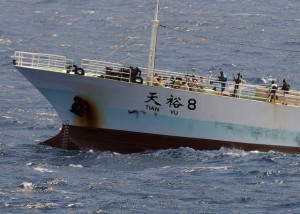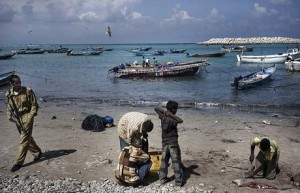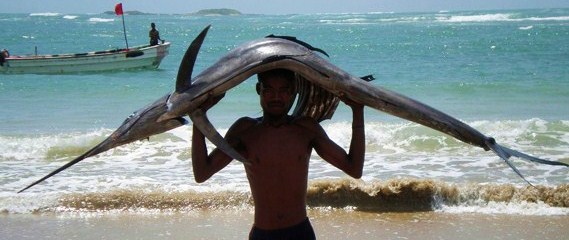East African Fishing, With A Catch.
 EUNAVFOR recently confirmed that the Kenyan flagged fishing vessel the Golden Wave was hijacked on 9 October 2010, with 43 crew onboard. Considering the International Maritime Bureau’s statistics on the types of vessels attacked over the past two years, fishing vessels are not the most common vessel to be attacked by pirates. In 2009 twelve fishing vessels were recorded to have been attacked globally, as opposed to 109 bulk carriers. Similarly, this year between January and June there were over three times as many attacks on chemical tankers in comparison with fishing vessels.
EUNAVFOR recently confirmed that the Kenyan flagged fishing vessel the Golden Wave was hijacked on 9 October 2010, with 43 crew onboard. Considering the International Maritime Bureau’s statistics on the types of vessels attacked over the past two years, fishing vessels are not the most common vessel to be attacked by pirates. In 2009 twelve fishing vessels were recorded to have been attacked globally, as opposed to 109 bulk carriers. Similarly, this year between January and June there were over three times as many attacks on chemical tankers in comparison with fishing vessels.
Whilst the lure of expensive cargoes and a larger potential ransom are likely to be driving a shift towards attacks on chemical tankers in the Gulf of Aden and Indian Ocean, the Spanish fishing trawler Alakrana’s ransom for around four million USD in November 2009 shows that certain fishing vessels remain lucrative targets. Captured fishing vessels have also been utilised as makeshift pirate motherships, with the Win Far 161’s use in an attack on the Maersk Alabama as a key example. In this particular instance however, the vessel’s release was secured with only a relatively small ransom and allegedly after the deaths of some of the crew whilst in captivity.
 Despite the low recorded figures, it is highly likely that attacks on fishing vessels are in reality far more numerous. With porous maritime borders, many fishermen and fishing vessels are neither recorded, nor insured and few have contact with regional authorities. As illustrated by their carriage of firearms whilst fishing, there is little doubt that Yemeni and Somali fishermen consider themselves under threat from foreign pirates, or each other. With low freeboards and long periods of time at slow speeds, fishing vessels are highly susceptible to pirate attacks. This vulnerability has led the Spanish fishing fleets operating off the East coast of Africa to lobby their government to place military vessel protection detachments onboard their vessels. Whilst the Spanish Government denied this request, they have permitted the use of private armed teams onboard the Spanish fishing vessels, with the critical and unusual caveat of military oversight of their operations.
Despite the low recorded figures, it is highly likely that attacks on fishing vessels are in reality far more numerous. With porous maritime borders, many fishermen and fishing vessels are neither recorded, nor insured and few have contact with regional authorities. As illustrated by their carriage of firearms whilst fishing, there is little doubt that Yemeni and Somali fishermen consider themselves under threat from foreign pirates, or each other. With low freeboards and long periods of time at slow speeds, fishing vessels are highly susceptible to pirate attacks. This vulnerability has led the Spanish fishing fleets operating off the East coast of Africa to lobby their government to place military vessel protection detachments onboard their vessels. Whilst the Spanish Government denied this request, they have permitted the use of private armed teams onboard the Spanish fishing vessels, with the critical and unusual caveat of military oversight of their operations.
 Without functioning control over Somalia’s maritime space and no formal claim to an Economic Exclusion Zone (EEZ), fishing off the Somali coast remains controversial. Externally, most analysts would argue that piracy off the Horn of Africa in 2010 is primarily an economically motivated act and therefore piracy in this region is considered as such. In contrast, political motivations would infer the label of maritime terrorism on these activities. Amongst other indicators, economic motivations and commercial interests behind the pirate business model off East Africa are apparent, especially so when one considers the IMB’s figures on the types of vessels attacked and the locations of their attacks. The vast majority of international vessels are, after guidance, avoiding a 200 nautical mile exclusion zone off the Somali coast, so what could once be considered a fisherman’s citizen arrest and fine have become a pirate’s hijack, kidnap and ransom.
Without functioning control over Somalia’s maritime space and no formal claim to an Economic Exclusion Zone (EEZ), fishing off the Somali coast remains controversial. Externally, most analysts would argue that piracy off the Horn of Africa in 2010 is primarily an economically motivated act and therefore piracy in this region is considered as such. In contrast, political motivations would infer the label of maritime terrorism on these activities. Amongst other indicators, economic motivations and commercial interests behind the pirate business model off East Africa are apparent, especially so when one considers the IMB’s figures on the types of vessels attacked and the locations of their attacks. The vast majority of international vessels are, after guidance, avoiding a 200 nautical mile exclusion zone off the Somali coast, so what could once be considered a fisherman’s citizen arrest and fine have become a pirate’s hijack, kidnap and ransom.
 Foreign fishing that is likely to be perceived as illegal by the populace on shore could encourage piracy, and continue to infer legitimacy upon pirate actions. Piracy can also establish income and control structures that become embedded in the absence of local governance. Whilst the ongoing violent power struggles between militant groups has the potential to shift the ever-mobile pirates from one safe haven to another, local populace attitudes towards pirate activity can also change. The inflationary impact of large pirate revenues on local economies and the shifting power structures and threats that come with pirate activity can operate as drivers for a change in local perceptions.
Foreign fishing that is likely to be perceived as illegal by the populace on shore could encourage piracy, and continue to infer legitimacy upon pirate actions. Piracy can also establish income and control structures that become embedded in the absence of local governance. Whilst the ongoing violent power struggles between militant groups has the potential to shift the ever-mobile pirates from one safe haven to another, local populace attitudes towards pirate activity can also change. The inflationary impact of large pirate revenues on local economies and the shifting power structures and threats that come with pirate activity can operate as drivers for a change in local perceptions.
Pirates require tacit local acceptance of their activities to operate, therefore initiatives to reduce local acceptance of pirate activity should be considered strongly. For all ship-owners and crews, fishermen or otherwise, the fact remains that their rights to safe navigation of the seas is under the threat of an illegal action under international law and their security concerns need to be addressed. These security problems are far from juxtaposed with those of the Somalian maritime communities.
The establishment of a Somali EEZ and indigenous fishery protection would not only benefit Somali maritime communities, but would pull the local legitimacy rug from underneath the pirates. As we are well aware, local Somali communities are far from powerless and can help reduce pirate activity. Given appropriate incentives, the Somali peoples are a powerful and integral force within an effective counter-piracy strategy on land. However, the longer we permit the pirates to establish themselves, the harder it will become to remove them.


I think that the Somalis do have an EEZ it came into being at the same time they signed to the ISPS codes, so I’m sorry but IMHO that won’t wash the pirate problem away. More has to be done to enforce the laws for the Somali’s and it’s not just the illegal fishing in their waters but also the dumping of contaminated waste by industrial nations that has been going on for years. I am not on the pirates side in this but it looks very to me like,” what no police? lets rob the bank!” attitude by many nations.
Oh and just to add some facts Somali territorial waters (TW), declared in 1972, consist of an 825,052km2 area. A 1989 exclusive economic zone (EEZ) overlays the same area as the TW. An additional 55,895km2 of continental shelf zone (CSZ) makes up Somali ocean territory.
The sum of the total internal area of Somalia of 637,657km2, together with the TW and EEZ, make up a total of 1,462,709km2, which with the additional CSZ expands to 1,518,604km2.
An interesting and important point David, illustrating that this is an area where clarity is crucial but hard to find.
As you identified, under their 1972 Law on Territorial Waters and Ports the Somalis have laid claim to Territorial Waters, 200nm from their baseline. However, Somalia signed and ratified UNCLOS which came into force in 1994. Simplifying things, although there are exceptions, under UNCLOS, Territorial Waters are 12nm. Somalia has not formally laid claim to a 200nm EEZ as they have continued to lay claim to 200nm Territorial Waters. – Although I have it on good authority that the Somalis may soon be formally claiming an EEZ. Watch this space.
I am inclined to agree with you that certain states and actors have flaunted and utilised the loop-holes and confusion over Somalia’s EEZ, and the instability within Somalia as a means to use Somalian waters to their own ends.
I also agree that laws are ineffective unless they can be enforced. To that end in the article I have argued for the establishment of indigenous fishery protection. However, in light of your comment, you are correct, I should have also stated an overall increase in Somali maritime governance that would include fishery protection should also include legal enforcement for dumping, smuggling, human-trafficking and piracy.
My key point was that the external imposition of a form of governance will not work; it needs to come from and be recognised internally. Moreover, whilst increased governance over the maritime domain will be difficult to achieve without increased governance on land, gaining the support of the maritime communities is a vital card on the table.
With regards to the ISPS code automatically identifying an EEZ for the Somalis, I am inclined to disagree, but you may well be correct. Could you please illustrate where? I am afraid I do not possess a copy. Alternatively I can get in touch with the IMO and inquire on your behalf.
Finally, the article you gleaned your figures from should be acknowledged, it makes some interesting though provocative points and continues to illustrate how the debate over Somalia’s EEZ rages on.
http://www.srilankaguardian.org/2010/09/real-pirates-in-somalia-washington.html